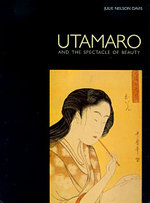The Spectacle of Beauty
Julie Nelson Davis reinterprets the works of artist Kitagawa Utamaro.

In late-18th-century Japan, the artist Kitagawa Utamaro held the city of Edo in thrall with his ukiyo-e prints. The genre of ukiyo-e, translated as “pictures of the floating world,” depicted worlds of pleasures and diversions afforded, in part, by the burgeoning urbanization of Japanese life. Utamaro specialized in images of beautiful women, including courtesans, geisha, housewives and shop girls, and depictions of the Yoshiwara, Edo’s licensed pleasure district. He also included his own likeness in one of his works, portraying himself as a sophisticated connoisseur of the Yoshiwara.
Despite being one of the most celebrated ukiyo-e artists of his time, little is currently known about Utamaro’s life. The few accounts that were written drew from a scarce number of sources, and due to this lack, relied upon his prints as though they were autobiographical. “There was this very literal reading from his prints to his life,” says Julie Nelson Davis, Associate Professor of Art History at Penn. “Previous writers on this topic had talked about Utamaro’s images as neutral, as though they depicted his lifestyle and the lifestyle of the pleasure district. They talked about his images of women as portraits of real women.”
In her new book, Utamaro and the Spectacle of Beauty, co-published by Reaktion Books and the University of Hawai'i Press, Davis closely studies selected print sets by Utamaro and his contemporaries. By drawing on a wide range of period sources, she reinterprets the artist in the context of his times. "I wanted to reverse this paradigm and look at these prints, not as documents of the time, but as advertisements for a lifestyle and as a marketing strategy for an artistic persona," Davis explains.
Davis has long been fascinated by the populist nature of print culture. “I was really interested in the idea of prints as cheap commodities that everyone could enjoy, as opposed to paintings, which only well-to-do people could buy,” Davis says. This was certainly the case for the print market in Edo during Utamaro’s time. In the late 18th century, Edo (modern-day Tokyo) was possibly one of the largest cities in the world. Of the 1.3 million people living there, 50 percent were merchants and artisans. They lived at the bottom of the social order under the Tokugawa shogunate, which held political control of the country. Ukiyo-e prints were primarily produced by and for this urban mix of merchant and artisans. Davis writes, “Ukiyo-e printed materials…expanded the market for visual images to a new range of clientele…its evolution as a distinct genre was effected by the combination of mercantile tastes and printing technologies to reach a broad market.”
Under the shogunate, the merchant and artisan class lived strictly proscribed lives — everything from where they could live to what they could wear was dictated to distinguish them from the ruling class. Nevertheless, as the wealth of this class increased, they developed an array of vibrant, urban pastimes. “Men of means,” Davis writes, “regardless of status…became accomplished poets, kabuki aficionados and patrons of the pleasure districts.” And Davis says that the Yoshiwara itself became “a kind of fetishized place, a place of imagination that became highly romanticized.”
Davis’ research suggests that ukiyo-e prints, rather than being straightforward renderings of life in Edo, marketed a coveted lifestyle of “cultured urbanity” and branded ukiyo-e artists as ambassadors of this lifestyle. An important part of Davis’ argument considers the fact that Utamaro’s primary publisher, Tsutaya Jūzaburō, also published guidebooks to the Yoshiwara that provided information about courtesans, their rankings and about the manners and customs of the district. “This is key because it suggests that the publisher had a relationship with the brothels,” Davis says, “and I started thinking about how Utamaro fit into all of this.”
Davis explains that the ukiyo-e market functioned something like today’s media market — “ultra-competitive and about topics that had a very short shelf life.” Davis recognized that Tsutaya needed to retain and promote artists who could keep selling, and this led her to reverse the dominant paradigm about Utamaro’s persona of worldliness. “It’s possible that it’s true,” Davis says, “but it’s also interesting to think about how his persona and fame works in context of a long-term marketing strategy by the publisher.”
This perspective also sheds new light on the women who were Utamaro’s primary subjects. The shogunate restricted what could be portrayed in ukiyo-e prints — sumo wrestlers, actors, and beautiful women, including licensed courtesans, were allowed but politics, history and anything considered debasing to public morals were not. By comparing Utamaro’s work with other contemporaneous images published, over and under the counter, Davis discovered that not all of his women were what they seemed on the surface. Some prints that overtly claimed to be naturalistic studies of women were also slyly disguised depictions of unlicensed prostitutes. By providing images of femininity deemed illicit by the shogunate, Utamaro and his publisher pushed against societal regulations. This secret code, however, also offered a provocative reward to the most dedicated patrons of ukiyo-e.

